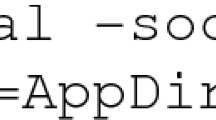Abstract
Mirrored disk systems provide high reliability by multiplexing disks. Performance is improved with parallel reads and shorter read seeks. However, writes must be performed by both disks, limiting performance. We introducedistorted mirrors, a mirroring system which combineswrite anywhere semantics with traditional database-specified block locations. This technique radically reduces the cost of small writes, making it attractive for random access applications such as OLTP, while retaining the ability to efficiently perform large sequential accesses. Distorted mirrors also scale better than traditional mirrors in terms of both disk caching and large mirrored sets. We show the effectiveness of distorted mirrors on the TP1 benchmark.
Similar content being viewed by others
References
Anonymous et al., “A measure of transaction processing power,”Datamation, vol. 31. no. 7, pp. 112–118, 1985.
K. Bates and M. TeGrotenhuis, “Shadowing boosts system reliability,”Comput. Design, 1985.
D. Bitton, “Arm scheduling in shadowed disks,” inProc. IEEE Computer Soc. Int. Conf. (COMP-CON), San Francisco, CA, 1989, pp. 132–136.
D. Bitton and J. Gray, “Disk shadowing,” inProc. Int. Conf. Very Large Data Bases, Los Angeles, CA, 1988, pp. 331–338
G. Copeland, W. Alexander, E. Boughter, and T. Keller, “Data placement in Bubba” inProc. Int. Conf. ACM SIGMOD, Chicago, IL, 1988, pp. 99–108.
D. DeWitt, S. Ghandeharizah, S. Schneider, H. Hsiao, and R. Rasmussen, “The gamma database machine project,”IEEE Trans. Knowledge Data Eng. vol. 2, no. 1, pp. 44–61, 1990.
J. Gray, B. Horst, and M. Walker, “Parity striping of disc arrays: Low-cost reliable storage with acceptable throughput,” Technical Report 90.2 Part Number 39596, Tandem Computers, Inc., 1990.
H. Hsiao and D. DeWitt, “Chained declustering: A new availability strategy for multiprocessor database machines,” inProc. IEEE Int. Conf. Data Engineering, Los Angeles, CA, 1990, pp. 456–465.
S. Leffler, M. McKusick, M. Karels, and J. Quarterman,The Design and Implementation of the 4.3BSD UNIX Operating System, Addison Wesley: Reading, MA, 1988.
J.M. Mott and J.C. O'Quin, “Auxiliary storage management in the AIX operating system,” IBM Risc System/6000 Manual, 1990.
J. Ousterhout, H. Da Costa, D. Harrison, J. Kunze, M. Kupfer, and J. Thompson, A trace-driven analysis of the UNIX 4.2 BSD file system, inProc. Symp. Operating Systems Principles, 1985, pp. 15–24.
D. Patterson, P. Chen, G. Gibson, and R. Katz, “Introduction to redundant arrays of inexpensive disks (RAID),” inProc. IEEE Computer Soc. Int. Conf. (COMPCON), San Francisco, CA, 1989, pp. 112–117.
M Rosenblum and J. Ousterbout, “The LFS storage manager,”Proc. Summer USENIX Conf, 1991, pp. 315–324.
R. Scranton, D. Thompson, and D. Hunter, “The access time myth,” IBM Technical Report RC 10197 (#45223), 1983.
J. Solworth and C. Orji, “Write-only disk caches,” inProc. Int. Conf. ACM SIGMOD, Atlantic City, NJ, 1990, pp. 123–132.
Tandem, “Configuring disks,”Tandem Sys. Rev., Dec. 1986.
The Tandem Database Group, “NonStop SQL, a distributed, high-performance, high-availability implementation of SQL,” inProc. Inter. Conf. ACM SIGMOD, Chicago, IL, 1988, pp. 337–341.
Teradata Corporation,DBC/1012 Database Computer System Manual Release 2.0, Document No.C10-0001-02, 1985.
C. Turbyfill, “Disk performance and access patterms for mixed database workloads,”Database Eng., vol.11, no. 1, pp. 48–54, 1988.
Author information
Authors and Affiliations
Rights and permissions
About this article
Cite this article
Solworth, J.A., Orji, C.U. Distorted mapping techniques to achieve high performance in mirrored disk systems. Distrib Parallel Databases 1, 81–102 (1993). https://doi.org/10.1007/BF01277521
Issue Date:
DOI: https://doi.org/10.1007/BF01277521




